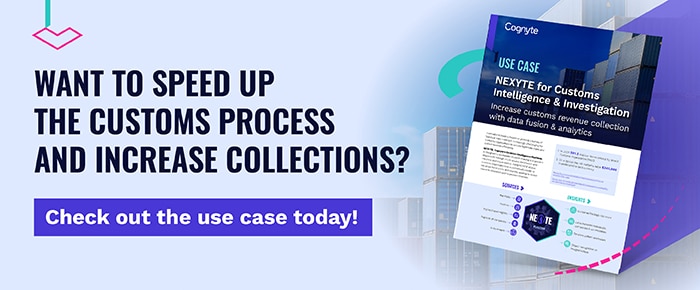Boost your Customs Risk Management with Data Analytics
How customs data analytics can lead to smarter risk management, increased revenue, and improved fraud detection

International trade generates growing volumes of data, making it increasingly challenging for customs organizations to regulate legitimate trade across air, land and sea and collect revenue effectively. Customs authorities face complicated tasks, including detecting smuggled goods (both illicit goods and goods without proper customs declaration), validating the declared value of goods, and confirming the origin and classification of goods. Organizations gather and analyze data to accomplish these tasks through multiple sources to identify relevant parties, movements of goods, storage of containers, means of transport, and various financial transactions. Given the size and scope of data, these organizations rely on customs risk assessment and customs management systems to investigate suspicious shipments and transactions and collect revenue.
The burden of analysis and investigation is a growing one, with global trade hitting an all-time high of $28.5 trillion in 2021. Customs authorities grapple with the task of maintaining their customs revenue collection by preventing fraud. The European Commission found that member states lost out on an estimated €134 billion in Value-Added Tax (VAT) in 2019. This figure included revenues lost to VAT fraud and evasion, as well as other factors. Having more streamlined customs management practices can help to mitigate these massive losses and ensure that governments are collecting the taxes and duties to which they are entitled.
Customs authorities must be concerned with more than customs revenue collection. Their work is essential to bolstering anti-money laundering efforts, preventing terror-related financing and arms smuggling, preserving cultural heritage, maintaining health and safety, stemming narcotics and weapons trade, protecting the environment, and more. The World Customs Organization proudly considers customs organizations to be at the forefront of combatting transnational crimes, by preventing money laundering and terrorist financing. Their 2021 report cites UN estimates that between $800 billion and $1.6 trillion in illicit funds are laundered annually across the globe, with $322 billion of that attributed to narcotics trafficking alone.
With such an important job to accomplish, customs organizations need the right tools to prevent illicit trade and customs tax evasion. Read on to learn how customs data analytics can lead to more efficient investigations.

What challenges do customs organizations face in risk management and fraud detection?
Customs investigations require professionals to manage and assess large volumes of data, often in a very short timeframe to ensure efficient trade. Authorities must reconcile data from shipping and cargo manifests, cargo declarations, invoices, import/export registries, Automatic identification systems (AIS) and movement tracking systems, registrars of companies, x-ray images, and more to build a cohesive understanding of shipments.
This data often lacks unique identifiers, making manual correlation difficult or impossible, especially given the time pressure. This, combined with the sheer volume of data, creates an insurmountable challenge to effective analysis. The challenge lies in the fact that the data has many different features and identifiers. Customs agents are charged with having to evaluate containers as well as individual goods within containers, which may come from different importers, may be recorded on different manifests and may be adherent to differing regulations. Customs authorities must often work statistically or through intelligence tips in order to make decisions, such as which trucks or shipping containers to open for inspection, which shipping or import/export companies to investigate, etc. These practices may sacrifice being thorough in an effort to be efficient. A proper solution would stem from the ability to turn scattered data points into a coherent single repository, so analysts can query all the data together to gain insights.
Investigations must have a streamlined customs case management system that can offer continuous insights based on current and past investigations, data sources, and intelligence tips. Such a system is necessary to fuse and analyze data for a cohesive investigation picture that can assess customs risks and provide alerts regarding instances of potential illicit trade and fraud.
How can customs data fusion and analysis mitigate fraud and increase revenues?
An advanced analytics platform can accelerate time-sensitive customs investigations by:
- Unifying customs investigations into a single workspace to save time and money: Analysts can fuse structured and unstructured data from multiple sources into a single pane-of-glass view to see a holistic view of each entity, whether it be a container, a ship, an import/export company, or a shipment, with unique identifiers to unify entities.
- Automatically assessing risks related to customs goods: Advanced analytics and machine learning algorithms automatically determine the risk score of containers and commodities. Analysts can also detect similar entities involved in suspicious shipments for further investigations.
- Detect and seize unauthorized shipments based on previously unattainable insights: Map hidden relations pertaining to individuals, companies, and commodities to automatically identify bad actors and detect illegitimate shipments.
To learn more about how you can improve the accuracy and speed of customs investigations, check out our use case on customs intelligence.